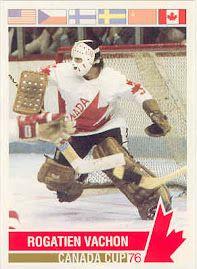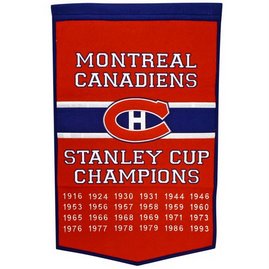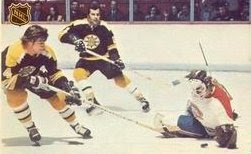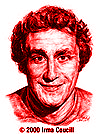
(Robert L Note: I came up with an awesome idea to share with other Habs fans, and the plan is to feature a different Montreal Canadiens goaltender throughout their history since 1909. I plan on posting them chronologically from that year on, until the present. Late last season, I ran a feature here entitled "Who Were These Masked Men?" that proved to be quite popular, and it started me on a ginormous task - finding out everything I could come up with on each and every goalie that belonged to the Montreal Canadiens in any form. The daily feature I plan to run, will not only cover the masked (and maskless) men who have tended goal for the Habs, but each and every one drafted, signed, bought, or even simply claimed on waivers who have been Canadiens property at one time or another. It will be a journey from Vezina to Price, with every twist and turn in between. By starting in hockey's most formative years, you will be able to witness not only the evolution of the game, but also of the position and the role it plays in a team's success.
This series is dedicated to the friends, young and old, made at this past weekend's Habs Fans Summit. I was extremely touched and overwhelmingly surprised by the words of kindness and complements brought on by people's reactions to Eyes On The Prize. Putting smilling faces on readers has had the effect of motivating me to do something special, in addition to the regular rants and raves usually posted on this site about current activities. Following games, and ups and downs in the current Habs scheme of the season, will be content focused on the present. On off days between games, the goalie bios will roll out one by one. I hope you all enjoy the trip back through time!)

A disclaimer - for clarity's sake, considering beginning's of the era and it's lack of proper verifyable documentation.
The beginnings of the Montreal Canadiens Hockey Club in the 1909-10 NHA season are extremely fuzzy and difficult to ascertain. The fact that it was almost 100 years ago makes things rather impossible to clarify for certain.
Four men played goal for the Canadiens in the 1909-10 season. As you will see, the details surrounding their debuts and performances may likely be forever lost to history. Only a fragment of what went on remains, the rest is blurred by time.
The two true goalies of the 4 who tended goal for the Canadiens in their inaugural season have become merely footnotes in time, while the other 2 who tended goal between them, are historical figures of prime importance in the story of the Montreal Canadiens.
In the origins of the game, players professional status was often debatable, nevermind their contractual obligations to an organization. Teams were moved and displaced in mid-season. There were few rules to abide by, and the era is one large, haphazardly, disorganized mess.
Often upon researching such times, facts conflict from source to source, making decisions as to what is really truth, practically impossible to verify.
Any eyewitnesses to happenings of the day would be 120 years old today - you get my drift?
In the 1909-10 season, and those that immediatly followed things changed extremely quickly in the burgeoning sport of hockey. The National Hockey Association (NHA) as it was know then, isn't very well documented. The NHL's earliest days are documented with much more clarity.
At that time in Canadiens history, you may have read that the hockey club initially went by the name of Club Athletique Canadien, using a C and then a CAC logo, before a potential lawsuit from a local athletic club of a similar name made team owners switch names to the current Club de Hockey Canadien (CHC), as it is still known and registered as a business today.
The CAC's initial season in the NHA also requires a certain scrutiny upon research as the 1909-10 season actually began twice. The league dropped its first ever games played from the record as teams folded, and restarted its season in January of 1910. The issue of melting outdoor ice for games also complicated matters.
Due to these auspicious beginnings, many facts were doublechecked when it came to determining which players actually played goal for the Canadiens in 1909-10.
Teddy Groulx was the first Montreal Canadiens goaltender on record, having signed with the team on January 29,1910.
Groulx himself is a man of complete mystery. There is no history as to where he came from or where he went after the season. All that is known is that the Canadiens won only 2 of their 16 games that season, and that Groulx was the winner of one. His season stats read: 7 games played, a 1 - 6 record, 420 minutes played, 62 goals against, and an 8.86 goals against average. Those stats might explain his disappearance.
The Canadiens second goaltender was a man known only as M. Larochelle. Many records fail to even confirm the first initial of his given name. I used the the book "La Glorieuse Histoire Des Canadiens" as my main reference, as in my Habs facets, it seems the most complete and best researched accountig available.
It is told that Larochelle didn't complete the game, which the Canadiens won, due to a dispute with an official. Seems he was tossed from the game after 67 minutes, a 7-6 OT win by the Habs, and was never to return. There are no pictures of Larochelle making history, and no personal information to record his place in history. There is simply text stating he was there, and then gone.
What is known of this mystery goalie, was that he belonged to the Montreal National of the LHCM in 1909-10. He was loaned to the Canadiens for the March 11, 1910 game in which he gave up four goals.
This game was the Canadiens second win in their history, the first having been a 9-5 result against the Haileybury Comets on February 26, 1910. The Canadiens had lost their first four games of it's history, including an inaugural 8-4 loss to the Ottawa Senators. Some accounts name the March 11 date as the first win while others claim it came in a matchup with the Cobalt Silver Kings, on January 5, 1910, in which Montreal won 7-6 in overtime.
Team manager, as they were termed in the day, Jean - Baptiste "Jack" Laviolette, took over in nets from Larochelle on March 11, 1910, and finished it, apparently being credited with winning the game. Laviolette was also the Canadiens manager, coach, captain, and best defenseman at the time.
Because of the cancelled beginning of the season, stats regarding Laviolette's stay between the posts cannot be determined precisely. It was mentioned at one source that he played in three additional games before handing puckstopping duties to another teammate, defenseman Joseph Cattarinich. Another source tells that it was managerial duties that were handed to Cattarinich after three games. My main reference book says that Laviolette allowed no goals in 5 minutes of play on the March 11, 7-6 overtime win.
As you see, it does not add up.
It is unclear as to whether Laviolette played in any games that where cancelled in late December 1909, or if the stats given refer only to the game he participated in after the 1910 new year and the restarted season.
One source credits Laviolette with the teams first goaltender win on a December 1909 date, while another states that the coach made official history (first substitute goalie credited with a win) by replacing Larochelle on March 11, 1910. That date would seem very late in the season to be considered fact.
Adding to the confusion, it is commonly known that the Ottawa Senators won the 1910 Stanley Cup on January 20.
In any regard, Canadiens defenseman Cattarinich became the teams next goaltender, out of sheer personal dedication to the team. The Cattarinich name will be very familiar to those who have researched the team's history, as he would become an eventual owner (1921-35), along with Louis Letourneaux and Leo Dandurand.
Cattarinich, the player, executive, and man of all trades, would be eventually be inducted into the Hockey Hall Of Fame in 1962.
Cattarinich was a defenseman and forward with the Montreal National from 1904 to 1909. He was born in Levis, Quebec on November 13, 1881, and passed away on December 8, 1938, at the age of 57 years old. As a goaltender, records state that he caught with his left hand, and was 5' 10" and weighed 167 lbs.
All in all, conflicting reports considered, the Canadiens first four goaltenders of record were, in no particular factual order, Groulx, Larochelle, Laviolette, and Cattarinich. Maybe your great, great grandfather could help clear up the facts! Thankfully, Cattarinich discovered the next Canadiens goaltender, and no such confusion would reign again.
Due to an absense of further info on Larochelle and Groulx, only the profiles of Laviolette and Cattarinich, neither career goaltenders, shall be included in this initial post on the Canadiens goaltenders of the 1909-10 season.
For bilingual Habs fans, further readings on the beginnings of the Canadiens, circa 1909, can be found at the "Bilan Du Ciecle" site from the University of Sherbrooke. Facts mix with myth - take 'em with a grain of salt!
December 4, 1909 - Creation of the Canadiens hockey team in the NHA.
January 5, 1910 - The Canadiens first game.
November 12, 1910 - Canadiens admitted into the NHA.

(Robert L Note: The following bios of Laviolette and Cattarinich, however confusing, were edited from several sources including the Hockey Hall Of Fame website, which can at times be astounding in it's errors and grammatical incompetence. The site needs an editor, big time!)
Jack Laviolette likely never imagined himself a goaltender.
A true "Jack-of-all-trades", Laviolette was an offensively gifted defender entrusted by the team owner as coach, manager, and captain of the Canadiens. It was therefore his duty, as he took it, to replace goaltender M. Larochelle when he was thrown out of the Canadiens initial contest for arguing a goal.
While there is no statistical data to matches of this early inaugural season in Canadiens history, it has been written that Laviolette tended goal for 3 additional games, all loses, before reassuming his prior duties. Goaltending tasks were handed to another Canadiens defenseman, Joseph Cattarinich, until a suitable replacement could be found.
Laviolette's true place in hockey history has less to do with his scoring prowess as a player (as a defenseman,he scored 45 goals in 147 games) for the Montreal Canadiens, and more to do with the fact that he was the first player, coach and GM of the team in the 1909-10 season. With the formation of the National Hockey Association (which became the NHL 7 seasons later), team / league owner Ambrose O'Brian asked Laviolette to put together a team made up of French Canadian players to form a franchise in Montreal.

Laviolette completed the task in time for the NHA's inaugural season. Among those that would sign on to that first team would be future Hall Of Famers Newsy Lalonde and Didier Pitre. He would add the "Chicoutimi Cucumber," goaltender Georges Vezina the following season, helping to make the Canadiens more competitive in their second year.
The team Laviolette built would go on to be the most successful franchise in professional hockey.
While a youth, Laviolette's family moved to Valleyfield, Quebec where he took up the sports of hockey and lacrosse at an early age. He began his organized hockey career in the Montreal City League and moved to the Montreal Nationals of the Federal Amateur Hockey League in 1904, finishing sixth in league scoring with eight goals in six games. He moved to the Michigan Soo Indians of the International Hockey League the following season where he scored 40 goals over three seasons and was named to the IHL First All-Star Team in 1905 and 1907 along with a being made a Second Team selection in 1906.

He was also lacrosse star with the Montreal Nationales in the early 1900's. In 1904 joined the professional team in Sault St. Marie, MI.
He returned to Montreal in the fall of 1907 to play hockey for the Shamrocks of the Eastern Canadian Amateur Hockey Association for two seasons before joining the National Hockey Association's Montreal Canadiens in their inaugural season of 1909-10.
Laviolette played on his only Stanley Cup winning team in 1915-16 when the Canadiens defeated the Portland Rosebuds 3-2 in a best-of-five series hosted by Montreal.
While tuning a car for a planned tour of Quebec in the summer of 1919, Laviolette crashed and lost his right foot in the mishap. His playing days were over. A benefit game for Jack was arranged at the Mount Royal Arena during the winter of 1921. Not only was he the guest of honour but he also refereed the game.
He was later inducted into Canada's Sports Hall of Fame as a lacrosse player. Jack Laviolette was inducted into the Hockey Hall of Fame in 1962.

Joseph Cattarinich, though not a goalie by trade, was the fourth man to tend goal for the Montreal Canadiens. A steady defenseman for the Canadiens, Cattarinich was asked by coach Jack Laviolette to replace him after three games in goal himself. It is assumed that he played in 5 games before a man named Teddy Groulx finished out the final 7 games of the season. No statistical data is available for Cattarinich's stint in goal.
Cattarinich's legacy as an important figure in the early annals of the Canadiens was likely cemented with the most astute of business decisions for the team. He solved its goaltending dilema.
Cattarinich discovered Georges Vezina in 1910 during a barnstorming match between Chicoutimi and the Montreal Canadiens. Vezina and his team of amateurs shut out the Habs, so impressing Montreal goalie Joseph Cattarinich that he persuaded Canadiens' owner George Kennedy to sign up Vezina, even though it would mean the end of Cattarinich's job. The "Chicoutimi Cucumber" would go on to play 328 league games and 39 more in the playoffs with the Canadiens from 1910 to 1926.

Known as a quiet, unselfish, but highly efficient businessman, Joseph Cattarinich's legacy was in helping to make the Montreal Canadiens one of the world's greatest sports franchises. He earned many admirers because he stressed making important and helpful decisions rather than gaining publicity for them. These decisive moves often based on financial assistance from Cattarinich who was generous, though not careless with his money.
Born in Levis, Quebec, across the St. Lawrence River from Quebec City, on November 13, 1881, Cattarinich played hockey and lacrosse as a youth. While tending goal for the Montreal Nationals of the CHA, he was impressed with the individual guarding the Chicoutimi net. He astutely recommended that the player in question, Georges Vezina, be brought in to replace him the following season. This selfless move for the betterment of the team was typical of Cattarinich in sports or business.
Originally a brakeman for Canadian Pacific, Cattarinich had met Dandurand in 1909 when he was part of the Montreal Lacrosse Club. The two would enjoy a long and prosperous partnership, working together in the tobacco and horse racing industries before achieving their greatest successes as owners of the Canadiens.

On November 3, 1921, Cattarinich and business partners Leo Dandurand and Louis Letourneau purchased the Montreal Canadiens from the widow of former owner George Kennedy for $11,000. Under their management, the Canadiens became the most exciting team in the NHL and were known as the "Flying Frenchmen" while winning three Stanley Cups. Some of the stars of this period included Howie Morenz, Aurel Joliat, Joe Malone, and Newsy Lalonde.
Louis Letourneau retired in 1931 leaving the other two to see the team through the Great Depression. Cattarinich's generosity was not killed off by these difficult times. He loaned Chicago's Major Frederic McLaughlin a vast sum of money to keep the team in business because it was for the good of the league. Finally, in 1935, Cattarinich and Dandurand sold the team for $165,000 for economic reasons.
Dandurand, Letourneau, and Cattarinich, owners of the Canadiens, presented an idea for a trophy to the National Hockey League in 1926-27 in memory of Georges Vezina. The outstanding goalkeeper collapsed during an NHL game Nov. 28, 1925, and died of tuberculosis a few months later.
After Letourneau retired and sold his interests in the team in 1931, Cattarinich and Dandurand were left to oversee the team through the Great Depression. Cattarinich's generosity was not killed off by these difficult times. He loaned Chicago's Major Frederic McLaughlin, the man who had named and ran the Black Hawks, a vast sum of money to keep the team in business because it was for the good of the league.
Upon the death of Habs legend Howie Morenz in 1937, all of the players personal items were to be auctionned off. Cattarinich could not attend, but asked that Jules Dugal, the Canadiens secretary treasurer, purchase the complete Morenz hockey outfit for $500. Cattarinich then turned over the outfit, giving it to Morenz' son Howie Jr.
The good deed is a fine example of the man whom Cattarinich was.
He was inducted to the Hockey Hall of Fame in 1977.
(Update: Following the publishing of this posting, Chuck, a regular reader of the site and a keen follower of Habs history went sleuthing to solve the mysteries of this most unusual of seasons. What he managed to come up was a more complete picture of what likely went on in 1910. By breaking down the goaltenders individual stats, Chuck sorts out what games were part of the original cancelled season, and which belonged to the two restarted seasons of record. By referencing several books on the matter, he then rolls out chronologically, the scores and goaltenders of each game. After I had banged my head on the subject of these four goalies for literally one month, searching for comprehension and clarity, Chuck's submission was quite the gift! Here is what he had to say, starting with a quick recap on the creation of the team and it's earliest days of existance.)
I was always under the impression that the original "Les Canadiens" franchise that was awarded to Ambrose O'Brien for the first NHA season in 1909-10 was suspended after that first year, and was eventually transferred to Toronto to become the Blueshirts for the 1912-13 season.
The apparent reason for this was that George Kennedy already owned the "Club Athletique Canadien" which was founded in 1908; to work out a name-infringement lawsuit O'Brien foreited the original Canadiens franchise on November 12, 1910 and received $7,500 from Kennedy to assume the rights to the players that were under contract with the original team. At that time, O'Brien also sold the rights to the Haileybury Comets franchise, which he also owned, to Kennedy... it was this franchise that he stocked with the former Les Canadiens players and re-christened it the Club Athletique Canadien.
This version of the story was referenced by Charles L. Coleman, Trail of the Stanley Cup, Kendall/Hunt (1964), p. 201. :
"George Kennedy, owner of the "Club Athlétique Canadien" founded a year earlier, claimed rights to the Canadiens name. To settle the dispute, a complex deal was worked out in the spring of 1910. Les Canadiens suspended operations for the 1910-11 NHA season (the franchise rights were taken over a year later by the Toronto Blueshirts), while Kennedy's team joined the NHA as its second Montreal franchise... Kennedy took over the franchise rights of the Haileybury Hockey Club. The Haileybury team had also been owned by O'Brien, but folded after the season when it became obvious that the mining town was too small to support a big-league hockey team; the remains of the club were sold to Kennedy as part of the deal with O'Brien."
Thus, George Kennedy was able to assimilate his Club Athletique Canadien with the Haileybury franchise for the 1910-11 NHA season. Technically then, the lineage for the current team would then go back through Kennedy's formation of the Club Athletique Canadien from 1909, and NOT back to the original franchise awarded to Ambrose O'Brien with the inception of the NHA.
If we accept this route, then theoretically anything to do with that original 1909-10 Canadiens team should not be part of the current team's history. However, since Kennedy assumed the name and the players from the 1909-10 squad, history acknowledges that the Canadiens played their first game on January 5, 1910. But even then, questions arise.
Regarding the Habs first win, well, it's more than a little foggy. Apparently the NHA restarted the season not once, but twice; the first restart was on January 5, 1910, with the first three Canadiens games from December 1909 of the proposed 16-game season having been stricken from the record.
The second restart came on January 15, 1910 after the Ottawa Senators and the Montreal Shamrocks were absorbed from the Canadian Hockey Association. From that point, the season would consist of a 12-game schedule. Because of this, the 7-6 overtime win versus the Cobalt Silver Kings didn’t count in the final standings, and probably shouldn’t be counted as their first win.
According to the stats that I have for the 1910 season, of the 12 remaining games that the Canadiens played, they lost the first four: to Renfrew on January 19, Ottawa (newly crowned Stanly Cup champions after having defeated a challenge from Edmonton of the Alberta Hockey League in Ottawa on January 18 & 20) on January 22 in Ottawa, again to Ottawa on January 26, and then to the Shamrocks on February 2.
Their first “official” win, i.e.: one that counted in league standings was by a 9-5 score over Haileybury on February 7, 1910. In a strange twist of history, it could then be said that the Canadiens beat themselves for their first win! They were to win their second game, the last of their first campaign, on March 11, 1910 when they defeated the Shamrocks by a 5-4 score in the 12th minute of overtime.
As far as the goaltending situation goes, here’s where it gets interesting. By combining your data and mine, I think we can come up with a plausible explanation of who played when.
Your info has Teddy Groulx signing with the team January 29, 1910; therefore it would be highly unlikely that he tended goal in the first 4 games on January 5, 19, 22, and 26. My stats have Teddy playing in 9 games, giving up 77 goals - which is the total number of goals that the Canadiens gave up in their final 9 games played after January 29.
It would then be safe to say that Teddy Groulx played the final 9 games of that season - never to be heard from again.
The three games following the January 15th re-start saw the Canadiens give up a total of 23 goals in three games; those totals agree with the season stats that I have for Joe Cattarinich. We could then say that he played on January 19, 22, and 26.
That leaves M. Larochelle and Jack Laviolette. Your info has Laviolette taking over for M. Larochelle in a 7-6 overtime win. The only game matching that score is the January 5 game against Cobalt, which is the only one not accounted for by Groulx or Cattarinich. Also, Laviolette is said to have felt that “it was his duty", as he took it, to replace goaltender M. Larochelle when he was thrown out of the Canadiens initial contest for arguing a goal.
Since it is widely accepted that the first game was January 5th, that seems to add extra credence to the argument that the duo of Larochelle and Laviolette were in nets on that date.
You also mention that Laviolette was the goaltender in three other games, which dovetails nicely into the theory the he was pencilled in as the team's goaltender for the first three games in 1909 that were stricken from the record, especially since he was given the task of assembling the team by Ambrose O’Brien.
My other reasoning for this timeline is that teams only carried one goaltender; it makes sense that one guy would play until the next guy took over for good, and didn’t switch games back and forth with a second goaltender.
Putting all of this info together, here’s my version of the earliest Canadiens goaltender history:
December 1909: The first three games of the proposed 16-game 1909-1910 season are stricken from the record. Jack Laviolette was the Canadiens goaltender for these three games.
January 5, 1910: The first re-start of the season, with M. Larochelle tending goal for all six goals allowed in a 7-6 overtime win over the Cobalt Silver Kings. Jack Laviolette replaces Larochelle after he’s tossed from the game.
January 15, 1910: The second re-start of the season after the Senators and Shamrocks are admitted to the league. Only the games after that point in the season (the final 12 games) count in the record books.
January 19, 1910: Renfrew 9, Canadiens 4. Cattarinich in goal.
January 22, 1910: Ottawa 6, Canadiens 4. Cattarinich in goal.
January 26, 1910: Ottawa 8, Canadiens 4. Cattarinich in goal.
January 29, 1910: Groulx signs with the Canadiens, takes over goaltending duties.
February 2, 1910: Shamrocks 8, Canadiens 3. Groulx in goal.
February 7, 1910: Canadiens 9, Haileybury 5. First of two Canadiens official wins on the season. Groulx in goal.
February 12 (Wanderers), February 15 (Renfrew), February 24 (Cobalt), February 26 (Haileybury), March 5 (Cobalt) and March 9 (Wanderers). Six more losses, all with Groulx in goal.
March 11, 1910: Final game of the 1910 season. The Canadiens defeat the Shamrocks 5-4 in overtime, giving Groulx his second win of the season.
The only chink in the armor is that you have Groulx playing the last 7 games and picking up the win in the last game, while my stats seem to lean towards Groulx playing in the final 9 games and picking up both official wins. Therefore the only two games in question would be February 2 against the Shamrocks and February 7 against Haileybury.
My thoughts are this: I find it unlikely that if the Canadiens found a need to replace Cattarinich, and had signed Groulx on January 29 that they would let Cattarinich play two more games (the second being a win) and bring Groulx into the lineup two weeks later.
Whatever the true history is, it sure makes some for some great sleuthing opportunities! It would be interesting to see what's in the Canadiens' archive that might be able to clear up some of the earliest questions surrounding the team.































































































































































8 comments:
Wow this is going to be a monumental task. i can't wait though. I love this site, I check it first thing every morning. Keep up the great work.
I grew up in the Cobalt/Haileybury/New Liskeard area(more commonly referred to locally as the Tri-Towns) and am aware of the history of that first game. The two towns in question regarding this game are located a mere five mailes apart. While the history of the Cobalt Silver Kings is better known, both towns briefly supported an NHA team in the early years. The O'Brien brothers owned silver mines in the area and supported the early NHA teams - they in fact had ownership in more than one of the teams at the same time, including the team from Cobalt. While the NHA records are definitely sketchy, there is significantly more evidence from the local history sources which indicates the fact that the first victory was indeed against the Cobalt Silver Kings than there is to support the date of the game against Haileybury. In fact Haileybury has rarely, if at all, made any claim to fame regarding this game, which is in direct contrast to the historical sources in Cobalt. Unfortunately the NHA records are incomplete, however there are many reputable sources which back up the Cobalt references......
beliveau1
Beliveau 1 - Any chances that there are pictures of that game in existance?
I am not aware of any but I have some connections still in the area - my son sits on the historical board for the town of Cobalt. So I have a bit of an in.....
If I can get my hands on any further info or corroboration I'll keep you informed. Cobalt has some excellent museums and historical archives dating back to the silver boom of the early 1900's.
Sounds like a good place to make a side trip to on our next travel team excursion. Thanks for the help.
Interesting little town that is definitely off the beaten path - it's located about 110 miles north of North Bay along Highway 11.
Once a booming silver mine capital with a population of over 22,000 people it is now a mere ghost of its' great past. Sadly it has dwindled to less than 1500 residents today as it struggles to survive beyond the mining boom era. However it was declared Ontario's most historical town recently and it has a wealth of museums & historical sites if someone is willing to go a bit further to see them.
Interesting little town that is definitely off the beaten path - it's located about 110 miles north of North Bay along Highway 11.
Once a booming silver mine capital with a population of over 22,000 people it is now a mere ghost of its' great past. Sadly it has dwindled to less than 1500 residents today as it struggles to survive beyond the mining boom era. However it was declared Ontario's most historical town recently and it has a wealth of museums & historical sites if someone is willing to go a bit further to see them.
Joseph Cattarinich goaled the three first official NHA games, then Teddy Groulx took his place (from a semi-pro team in Mauricie). Cattarinich came back for one game. Larochelle was in the pipes for the last game. He had played all season for National Intermédiaire. He was ejected in overtime (although, according to La Patrie, Groulx was ejected).
Post a Comment